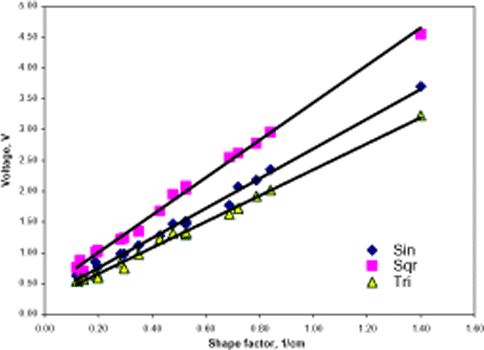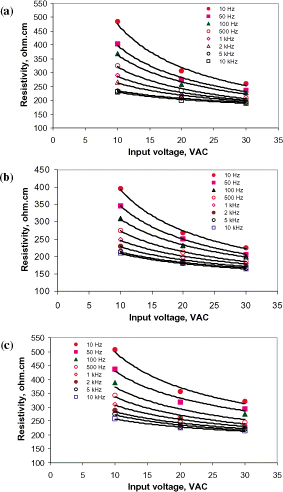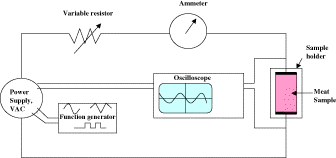Abstract
Electrical resistivity and anisotropy of goat meat (hind leg muscle) were investigated with respect to low input voltages of 10, 20, and 30 V ac, in the frequency range of 10–10 kHz. Three waveforms used were, Sinusoidal, Square, and Triangular. Input voltage, frequency, and waveform, both individually and in combinations, affected the resistivity of goat meat. The resistivity values decreased with the increase in both the voltage and frequency under all the three waveforms. Square wave produced the least resistivity, while triangular waves produced the highest. Resistivity across the the myofiber axes was significantly higher than along the myofiber axes.
Introduction
Electrical properties of meat have become an important area of research interest in the recent years in order to develop adequate process to ensure quality and safety of meat products. The electrical stimulation of the carcass was a major focus of attention in the science of meat processing, especially during the past three decades. The basic goal of such electrical stimulation was to improve meat quality and guard against cold shortening.Citation1 There are a number of studies reported in the literature on beef, pork, and lamb. Bawcom et al.Citation2 used a hog stunner modified with two probes, placed opposite ends of beef steak samples, to apply electrical current for the reduction of microorganisms on the steak surface. Similar experiment was also reported by Tinney et al.Citation3 to control E. coli O157 on beefsteak. SwatlandCitation4 reported that the resistivity of beef muscle was anisotropic with minimum resistivity along the myofiber axes and maximum resistivity across the myofiber axes. Resistivity values were seen to increase during 2–8 h postmortem that eventually declined afterwards. Decline in the pH value influenced the decline in the resistivity.Citation5 Electrical stimulation within three min post mortem improved muscle tenderness in lamb thorasic and semi-membranous muscles.Citation6 Ho et al.Citation7 modeled the voltage waveform for pulsed electric field across a batch treatment channel as a function of applied voltage, time, and circuit elements. The model was determined for orange juice, apple cider, whole milk and skim milk.
However, studies on the electrical properties of goat meat are very scanty if not absent. Understanding of the electrical property of goat meat would enable us to optimize the electrical parameters that could be used in various meat processing activities like disinfecting the meat from harmful pathogens and at the same time tenderizing the meat. The objectives of this study were to measure the resistivity and investigate the possible anisotropy of goat meat (hind leg muscle) with respect to applied input voltage, frequency of the voltage and waveform.
Materials and Methods
A series ac circuit, as shown in Fig. , was built to measure the current and output voltage across the sample. An ac power supply was chosen in order to avoid the electrode polarization that could cause erroneous resistance measurement with dc ohmmeter. The resistivity behavior of goat meat under the three input voltages: 10, 20, and 30 V ac, eight frequencies: 10, 50, 100, 500, 1 k, 2 k, 5 k, and 10 kHz, and three waveforms: Sinusoidal, Square and Triangular, were investigated. A power supply system including a function generator (Function Generator Model 4071A, 10 MHz, BK Precision, Placentia, CA) and power modulation unit (Bipolar Operational Amplifier, 36 V-12 A, KEPCO, Flushing, Inc., NY), were used. Type of waveform, the desired magnitude of the voltage and the frequency of the voltage signal were set through the function generator. Both the input and output voltages were monitored through an Oscilloscope (Model 2221A, Tektronix, Inc., Beaverton, OR). The current through the sample and the output RMS voltage across the sample were measured with digital multi-meters (Dual Display Digital Multimeter Model gdm 8245, GM Instrument Co., Taipei, Taiwan).
Meat samples from hind leg muscles of goat (Spanish doe, 8 mo of age, average weight 25 kg, raised on pasture with a grain supplement), chilled at 4°C for 24 h after slaughter, and subsequently stored frozen at −30°C for about a week, was used for the tests. Sample dimensions were chosen carefully to obtain shape factors in the range of 0.2–1.4. Lean meat of approximately uniform texture was used for the tests. The frozen test samples were gradually thawed to room temperatures between 15 and 20°C before the tests. These tests were conducted on meat samples at random irrespective of muscle fiber orientation. Exudation and or condensate from the meat sample were always blotted out to ensure current flow through the meat only. For the determination of the resistivity the current flow through the sample and voltage drop across it were measured.
The experiments were laid out in the Split-Split-Plot experimental design. Three levels of voltage, eight levels of frequencies and three levels of waveforms were used in successive order. The experiments were replicated three times. The data were statistically analyzed according to split-split-plot analyses of variance using SAS system for windows V8.
To investigate anisotropy, the same meat sample was tested for resistivity in two orientations, along and across the myofiber axes. Paired T-test was performed with the data to test the difference between the resistivity of the meat across and along the myofiber axes. The resistivity values corresponding to the combined treatments of the two voltages (10 and 20 V ac), the three waveforms (sine, square, and triangular), and four frequencies (10, 100, 1 k, and 10 kHz), were pooled for paired T-test. The analyses were done using SAS system for windows V8.
Results and Discussion
The Trends of Output Voltage and Current Through Meat Samples
General trend of the electric current through the sample of goat meat is presented in Fig. corresponding to 20 V and 100 Hz. The current decreased with the increase in the shape factor of the meat sample, defined by φ = l/A (where l is the length and A is the area of cross-section of the meat sample), as expected according to ohms law. The magnitude of the current due to square-wave voltage was always the highest among the three waveforms at all combinations of input voltage and frequencies, followed by sinusoidal and triangular wave signals. The influence of frequency was also very significant. Output voltage drop across the sample length always increased with the increase in the shape factor. An example of output voltage trend is presented in Fig. for 20 V and 100 Hz. The rate of increase of the voltage was the highest in square-wave followed by sinusoidal and triangular waves, respectively.
Figure 3. Output voltage across the goat meat sample when 20 V, 100 Hz electricity was applied across it.

Impedance across the sample was calculated from the RMS values of the current and the corresponding output voltage. The impedance increased with the increase in shape factor. Impedance values were plotted against the corresponding shape factors and straight lines were fitted to the data. The slope of the line, passing almost through the origin, gave the resistivity value for the sample meat, following the relation: Z R = ρ φ (where, Z = impedance, ρ = resistivity, and φ = shape factor).
Effect of Input Voltage, Frequency, and Waveform on the Resistivity of Goat Meat
It was observed from the split-split-plot analysis of variance that the resistivity was significantly (p < 0.01) affected by voltage, type of the waveform, and the frequency of the supply voltage. The interactions among the three independent variables were also found highly significant (p < 0.01). The results thus indicated that voltage, frequency, and the waveform, both individually as well as in combinations, affected the resistivity property in goat meat. The resistivity values in the frequency range from 10 to 500 Hz decreased faster than the subsequent higher frequencies. At frequencies greater than 500 Hz, the resistivity values continued to decrease but gradually at a slow rate.
The effects of the three input voltages and frequency on the resistivity values are presented in Figs. a–b, respectively, for sinusoidal, square, and triangular waves. The data of resistivity were plotted against log scale of frequency, and power curves were fitted with a very high value of coefficient of determination. A generalized form of the relationship thus evolved for resistivity may be expressed as follows:
Table 1 Values of A and k in the resistivity model, ρ = A (log f)−k ), with respect to input voltage and waveforms, where ρ = resistivity, and f = frequency
Figure 4. (a) Effects of voltage and frequency on the resistivity in sinusoidal wave regime; (b) Effects of voltage and frequency on the resistivity in square wave regime; (c) Effects of voltage and frequency on the resistivity in sawtooth wave regime.

Figure 5. (a) Effects of input voltage and frequency on the resistivity of goat meat in the sinusoidal wave regime; (b) Effects of input voltage and frequency on the resistivity of goat meat in the square wave regime; (c) Effects of input voltage and frequency on the resistivity of goat meat in the sawtooth wave regime.

Anisotropy in Goat Meat
Mean values of resistivity corresponding to the two muscle fiber orientations are shown in Table . It is evident that the resistivity values were consistently higher in across the myofiber axes than along the myofiber axes, irrespective of input voltage and waveform. However, there is a decreasing trend in the difference of the resistivity values as the input voltage increased from 10 to 20 V. These results are very much in agreement with those of Swatland.Citation4 Generally, in all combinations of voltages, frequencies, and waveforms, the resistivity across the myofiber axes was higher than along the myofiber axes. The resistivity values, obtained from the combined treatments of the two voltages (10 and 20 V ac), the three waveforms (sine, square and triangular), and four frequencies (10, 100, 1 k, and 10 kHz), were pooled and subjected to paired T-test. The result of paired T-test indicated that the difference in the resistivity values between the two were highly significant (p < 0.01). Such a response seems to be technically plausible due to the fact that the myofibers are embedded in a mesh of connective tissues, namely, collagen.Citation8 The collagen constitutes the major part of muscle fiber. The amount and quality of collagen, however, varies with respect to the age and species of the animal. These connective tissues are much tougher than myofibers. Also there are fatty tissues present in inter muscular bundles that are good insulators to the electricity. It is possible that these connective tissues together with the fat tissues are the source of greater resistivity across the muscle fiber than along the fiber.
Table 2 Mean resistivity values of goat meat, across and along the myofiber axes, from pooled data for four frequencies (10, 100, 1 k, and 10 kHz)
Conclusions
Electrical series circuit was adequate to measure the resistivity of goat meat. Input voltage, frequency, and waveform, both individually and in combinations, affected the resistivity of goat meat. Square wave produced the least resistivity effect in all the voltage and frequency treatments, in the range of 10–30 V ac, and 10 Hz to 10 kHz frequencies. Highest resistivity values were produced by triangular wave, followed by sinusoidal wave. The resistivity accross the myofiber axes was significantly higher than that of along the myofiber axes.
References
- Bouton , P.E. , Ford , A.L. , Harris , P.V. and Shaw , F.D. 1978 . Effect of low voltage stimulation of beef carcass on muscle tenderness and pH . J. Food Sci. , 43 : 1392
- Bawcom , D.W. , Thompson , L.D. , Miller , M.F. and Ramsey , C.B. 1995 . Reduction of microorganism on beef surfaces utilizing electricity . J. Food Prot. , 58 : 35 – 38 . [CSA]
- Tinney , K.S. , Miller , M.F. , Ramsey , C.B. , Thompson , L.D. and Carr , M.A. 1997 . Reduction of microorganism on beef surfaces with electricity and acetic acid . J. Food Protection. , 60 ( 6 ) : 625 – 628 . [CSA]
- Swatland , H.J. 1980a . Anisotropy and postmortem changes in the electrical resistivity and capacitance of skeletal muscle . J. Animal Sci. , 50 ( 1 ) : 67 – 74 .
- Swatland , H.J. 1980b . Postmortem changes in electrical capacitance and resistivity of pork . J. Animal Sci. , 51 ( 5 ) : 1108 – 1112 .
- Lee , S. , Polidori , P. , Kauffman , R.G. and Kim , B.C. 2000 . Low-voltage electrical stimulation effects on proteolysis and lamb tenderness . Food Chem. and Toxicology , 65 ( 5 ) : 786 – 790 .
- Ho , S.Y. , Mittal , G.S and Cross , J.D. 2003 . Determination of electrical parameters of a liquid predicting waveforms of high-voltage low-energy pulses . Int. J. Food. Prop. , 6 ( 1 ) : 115 – 126 . [CROSSREF]
- Kannan , G. , Chawan , C.B. , Kouaku , B. and Gelaye , S. 2002 . Influence of packaging method and storage on shear value and mechanical strength of intermuscular connective tissue of chevon . J. Anim. Sci. , 80 : 2383 – 2389 .

